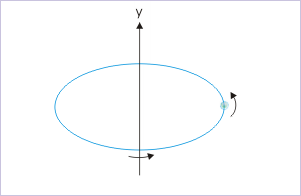| << Chapter < Page | Chapter >> Page > |
Conservation of angular momentum is a powerful general law that encapsulates various aspects of motion as a result of internal interactions. The conservation laws, including this one, actually addresses situations of motions, which otherwise can not be dealt easily by direction application of Newton's law of motion. We encounter rotation, in which the rotating body is changing mass distribution and hence moment of inertia. For example, a spring board diver or a skater displays splendid rotational acrobatics by manipulating mass distribution about the axis of rotation. Could we deal such situation easily with Newton's law (in the angular form)? Analysis of motions like these is best suited to the law of conservation of angular momentum.
Conservation of angular momentum is generally believed to be the counterpart of conservation of linear momentum as studied in the case of translation. This perception is essentially flawed. As a matter of fact, this is a generalized law of conservation applicable to all types of motions. We must realize that conservation law of linear momentum is a subset of more general conservation law of angular momentum. Angular quantities are all inclusive of linear and rotational quantities. As such, conservation of angular momentum is also all inclusive. However, this law is regarded to suit situations, which involve rotation. This is the reason that we tend to identify this conservation law with rotational motion.
The domain of application for different conservation laws are different. The conservation law pertaining to linear momentum is broader than force analysis, but limited in scope to translational motions. Conservation of energy, on the other hand, is all inclusive kind of analysis framework as we can write energy conservation for both pure and impure motion types, involving translation and rotation. Theoretically, however, energy conservation is limited at nuclear or sub-atomic level or at high speed translation as mass and energy becomes indistinguishable. These exceptional limits of energy conservation can, however, be overcome simply by substituting energy conservation by an equivalent "mass-energy" conservation law. In this context, conservation of angular momentum is as general as "mass-energy" conservation law to the extent that it is valid at extreme bounds of sub-atomic, nuclear and high speed motions.
What is conserved in the uniform circular motion of a particle?
Uniform circular motion

The uniform circular motion is characterized by constant speed. Hence, speed is conserved.
The particle continuously changes direction. Hence, velocity is not conserved.
The particle would move along a straight line if there is no external force. However, the particle changes direction. It means that there is an external force on the particle. This force is called centripetal force. As there is an external force on the particle, linear momentum (m v ) is not conserved. We can also simply conclude the same saying that since velocity is not conserved, the linear momentum of the particle (m v ) is not conserved.
The particle has constant angular velocity (ω) and constant moment of inertia (I) about the axis of rotation. Hence, angular momentum (Iω) is conserved. We can look at the situation in yet another way. The only external force involved here is centripetal force, which is radial and passes through the axis of rotation of the particle. Thus, there is no external torque ( τ ) on the particle. As such, angular momentum of the particle is conserved.
Hence, options (a) and (d) are correct.

Notification Switch
Would you like to follow the 'Physics for k-12' conversation and receive update notifications?